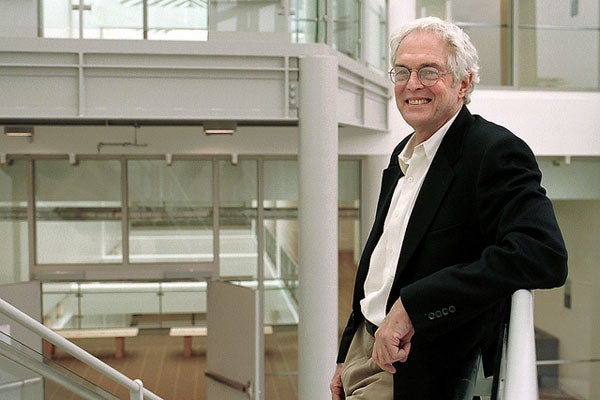Thomas Cover, one of the world’s top information theorists and a professor of electrical engineering and of statistics at Stanford University, died March 26 at Stanford Hospital at the age of 73.
“A senior colleague at MIT often referred to Tom Cover as ‘the jewel in Stanford’s crown.’ He certainly was,” said Abbas El Gamal, professor of electrical engineering. “Not only was he one of the greatest information theorists since Claude Shannon (and the one most like Shannon in approach, clarity, and taste), but he was also one of Stanford’s most inspiring teachers and mentors. “I am truly privileged to have been his student, colleague, and friend for the past 37 years. It is a huge loss for all of us.”
“Tom Cover was wry, amusing, and interesting on almost any topic, especially favorites like betting and sports – especially Stanford sports,” said longtime friend and colleague Bradley Efron, a professor of statistics at Stanford. “He was serious on just one topic, however: science, where his work on information theory set the bar worldwide.”
Cover was a man of remarkable breadth in his research interests, making notable contributions in fields ranging from information theory and mathematical statistics to data compression, pattern recognition and stock market investment strategies.
Cover’s work in information theory, which treats all information as mathematically quantifiable, was profound. With Joy A. Thomas, Cover wrote Elements of Information Theory, a book regarded by many as the benchmark text on modern information theory. The book has been called a masterpiece for the clarity of its concepts and the simplicity of its exposition.
In 1973, Cover introduced the groundbreaking concept of superposition of signals in broadcast channels, making possible the simultaneous transmission of information from one transmitter to several receivers. His work likewise played a major role in data compression algorithms used in wireless communications.
Cover’s “Nearest-Neighbor Rule” quantified the notion that objects that appear alike are, in fact, alike. It became a cornerstone in the theory of pattern recognition.
Cover’s notable love of games and gambling strategies had a long history. It began when he was a graduate student intrigued by the work of statisticians David Blackwell at the University of California-Berkeley and Herbert Robbins at Columbia and their theory for repetitive games, such as predicting the outcome of coin flips.
This expertise led to Cover’s tenure as a statistician for the California State Lottery, under contract from 1986 to 1994, while he remained on the faculty at Stanford. During his time with the lottery, Cover variously designed tests for lottery balls and wheels, analyzed the payoff structure of games and devised ways to beat the lottery in order to anticipate and defeat fraud.
Cover loved sports. As a boy, he played in the Little League World Series, ran cross-country and won the San Bernardino tennis championship. At MIT, he played varsity tennis. His athletic experiences led to a highly popular class at Stanford, Mathematics of Sports, and several of his students went on to become statisticians in the NFL and Major League Baseball.
This deep interest in games led to a discovery that the mathematics of games can be applied to other forms of gambling, as well, namely stock market investment. Beginning in 1980, and playing out over the course of the next quarter century, Cover and several co-authors published a series of papers on mathematical approaches to portfolio strategy drawn from the principles of information theory.
“What was most impressive about Tom was his legendary creativity and brilliance,” remembered Andrea Goldsmith, a professor of electrical engineering, colleague and friend. “No one thought about technical problems the way Tom did. He was able to crack some of the most challenging problems in information theory with elegance and beauty. He was always interested in discussing new ideas with me, even when I was just a graduate student at Berkeley. His humility and openness served as an inspiration throughout my time at Stanford.”
“Tom was my lifelong friend, from when we both arrived as new graduate students in 1960. He is irreplaceable and is already sorely missed,” said Efron.
During Cover’s 48 years as a professor at Stanford, he graduated 63 PhD students and authored over 120 journal papers. One former student opined on a memorial website, “information theory without Tom is like opera without Mozart.”
Born in San Bernardino, California, on August 7, 1938, Thomas M. Cover received a B.S. in physics from the Massachusetts Institute of Technology in 1960, and M.S. and Ph.D. degrees, both in electrical engineering, from Stanford in 1961 and 1964, respectively.
Cover joined the faculty at the Stanford School of Engineering in 1964, becoming a professor in 1972. He directed Stanford’s Information Systems Laboratory from 1988 to 1996. In 1994, he was named the Kwoh-Ting Li Professor of Electrical Engineering and Statistics.
In 1990, the Information Theory Society of the IEEE awarded him the Claude E. Shannon Award, the highest honor for lifetime achievement in information theory. In 1997, the IEEE awarded him the Richard W. Hamming medal for “fundamental work in information theory, statistics and pattern recognition.”
Cover was past president of the IEEE Information Theory Society. He was elected to the National Academy of Engineering, and named as a Fellow by the American Association for the Advancement of Science, the Institute of Mathematical Statistics and the IEEE. In 2003, he was elected to the American Academy of Arts and Sciences.
Tom Cover is survived by his wife, Karen, a son, Bill, a daughter, Cindy Black, and a stepson, Gordon Fields; three brothers, Bill, Chuck and John; and four grandchildren, Carolina, Jon, Brian and Laura.
A memorial service is planned for October 12, 2012 at the University Alumni Center.
Andrew Myers is the associate director of communications for the Stanford University School of Engineering.
